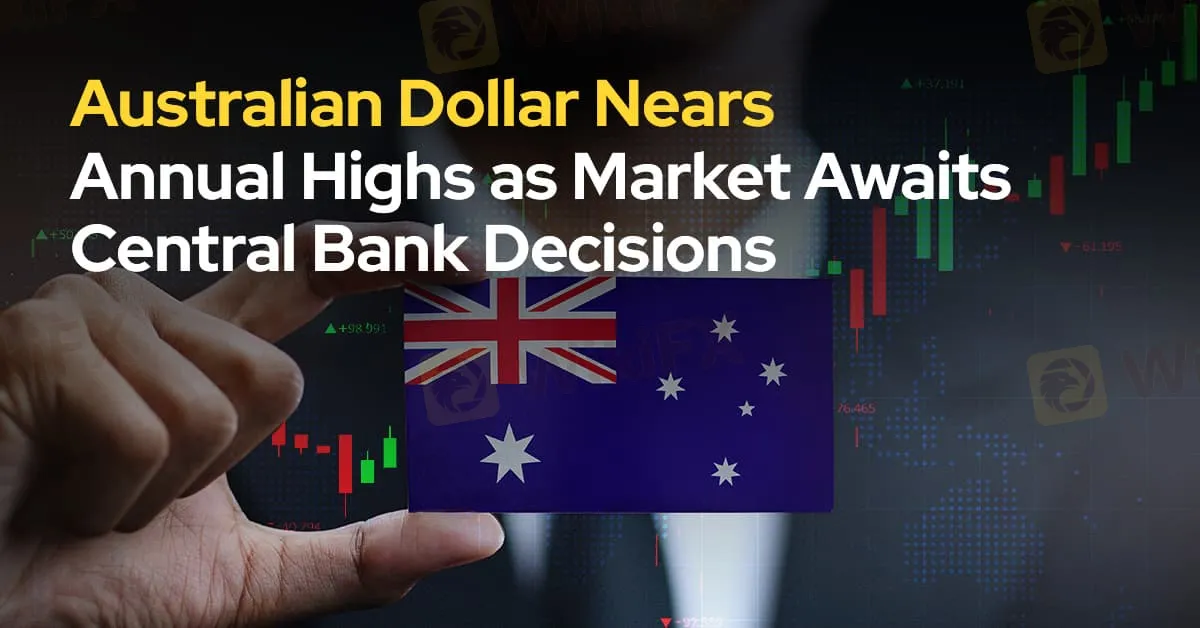简体中文
繁體中文
English
Pусский
日本語
ภาษาไทย
Tiếng Việt
Bahasa Indonesia
Español
हिन्दी
Filippiiniläinen
Français
Deutsch
Português
Türkçe
한국어
العربية
Australian Dollar Nears Annual Highs as Market Awaits Central Bank Decisions
Abstract:According to a report, the Australian dollar edged close to its highest point this year, trading at $0.6839 after a solid 0.45% increase.

According to a report, the Australian dollar edged close to its highest point this year, trading at $0.6839 after a solid 0.45% increase. This rise coincides with the Reserve Bank of Australia (RBA) expected to hold interest rates steady, prompting traders to speculate on any signals regarding potential easing. Among 44 economists surveyed, only four foresee a rate cut by December, while traders estimate a 60% likelihood.
The currency's strength is bolstered by recent stimulus measures from the People's Bank of China (PBoC), including a 50 basis point reduction in banks' reserve requirements, which contributed to a slight dip in the yuan. Initially, the yuan fell by 0.16% in offshore trading but later stabilized around 7.0590 per dollar. Markets analyst Tony Sycamore noted that once the RBA's meeting concludes, the Aussie might rally towards 70 cents by the end of the year.
Meanwhile, the Japanese yen remained stable at 143.495 against the dollar as traders anticipated insights from Bank of Japan Governor Kazuo Ueda regarding future interest rate adjustments. The euro, recovering from a nearly 0.5% decline driven by lackluster business activity surveys, was holding steady at $1.1105. Sterling, too, remained near a 2-1/2-year high at $1.33445, supported by the Bank of England's careful approach to potential rate cuts.
In summary, central bank policies and economic trends are pivotal in shaping the current currency landscape, creating an atmosphere ripe for volatility in the markets.

Disclaimer:
The views in this article only represent the author's personal views, and do not constitute investment advice on this platform. This platform does not guarantee the accuracy, completeness and timeliness of the information in the article, and will not be liable for any loss caused by the use of or reliance on the information in the article.
Read more

OctaFX Flagged by Malaysian Authorities
OctaFX has been officially listed on warning lists by both Bank Negara Malaysia (BNM) and the Securities Commission Malaysia (SC). These alerts raise serious concerns about the broker’s status and whether it is legally allowed to operate in Malaysia.

TradingPRO: A Closer Look at Its Licences
In an industry where safety and transparency are essential, the regulatory status of online brokers has never been more important. For traders seeking to protect their capital, ensuring that a platform operates under recognised and stringent oversight can make all the difference. Keep reading to learn more about TradingPRO and its licenses.

Oil Price Breakout Incoming? Investors Should Stay Alert
Oil prices are hovering around a critical level, with potential yet to be fully unleashed. Investors must prepare for sudden changes.

New SEBI Regulations on Intraday Trading
The Securities and Exchange Board of India (SEBI) has implemented revised regulations on Intraday trading, with effect from November 20, 2024. These regulations are meant to lessen risks and prevent speculative trading practices.
WikiFX Broker
Latest News
How much money will you earn by investing in Vantage Broker?
IronFX vs Exness Review 2025: Comprehensive Broker Comparison
Fraudsters Are Targeting Interactive Brokers' Users with Lookalike Emails
Everything you need to know about ADSS
SkyLine Guide 2025 Malaysia: 100 Esteemed Judges Successfully Assembled
Vantage Markets Review 2025: Trusted Forex and CFD Trading Since 2009
Top Tips to Choose the Best Forex Broker in 2025
SEBI Notifies New F&O Rules for Investors - New Derivative Trading Limits & More Amendments
Interactive Brokers: Global Office Visits and Licensing Details
U.S. Jobs Data Released: A Potential Boost for Gold Prices
Currency Calculator


